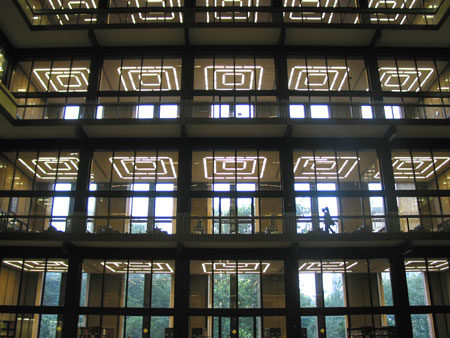Saturday morning provided orphanistas a glimpse into the advances in digital preservation, or what Jim Lindner described as, “MIAP work for the next 20 years.” The final day of our beloved symposium began with a discussion of the newly developed System for Automated Migration of Media Assets (SAMMA) and its use at NYU’s very own Fales Library. Ann Butler, Senior Archivist at Fales, introduced our first panel, “New Frontiers in Digitizing Legacy Videotapes.” She described the Fales Downtown Collection, which was established in the mid 1990s to document the downtown New York art scene from the 1970s through the present. Designed as a “neighborhood” collection, it contains over 10,000 linear feet of material including 7,500 video items, 2,400 film items, and 7,800 audio items. While many of the artists, or their respective estates, are actively engaged with the material in the collection, the formats are becoming increasingly “orphaned” in the technological sense.


Bobst Library, the home of the Fales Collection, courtesy of Blue Jake
Enter Jim Lindner, a respected authority on preservation and migration of electronic media. Jim echoed Ann’s concerns about the problem of format obsolescence along with tape deterioration. In 2001, Jim helped to develop SAMMA, a videotape to digital file migration system. The automated SAMMA is essentially a robot which takes a tape, uses a gentle archival cleaner, analyzes the signal of the tape, and encodes it into a digital file. SAMMA can convert from any format (Betacam, Digibeta, U-matic, VHS, etc.) to any digital output format. Throughout the migration process, the SAMMA system also closely monitors the tape, looking at every frame and collecting extensive metadata. Therefore, those using the machine can get an unbiased analysis of the image quality and invaluable statistical information about the video without actually looking at the video itself (and possibly damaging it further). SAMMA also produces a less expensive, semi-automated machine, SAMMA solo, which was recently used to digitize U-matic tapes in the Downtown Collection.
Sarah Zieball, former Moving Image Preservation Specialist for NYU’s libraries, explained how Fales became a beta test site for the SAMMA solo machine. The machine helped digitize almost 300 U-matic works in a little over three months and allowed Fales to test their technological “readiness” for digitization projects of this kind. Sarah also explained how SAMMA solo encouraged Fales to adopt an alternative appraisal model. While Fales archivists were accustomed to appraising material first, SAMMA digitizes items first and then provides information with which the material can be appraised for curatorial value.
To conclude the panel, Brent Phillips, Media Specialist at Fales, gave us an overview of the content of the newly digitized material, including how many tapes were migrated and their current preservation formats. We were then treated to a 7-minute collection of clips including video of graffiti artists in New York City, a promotion for Creative Time, and a trippy appearance by Allen Ginsberg.